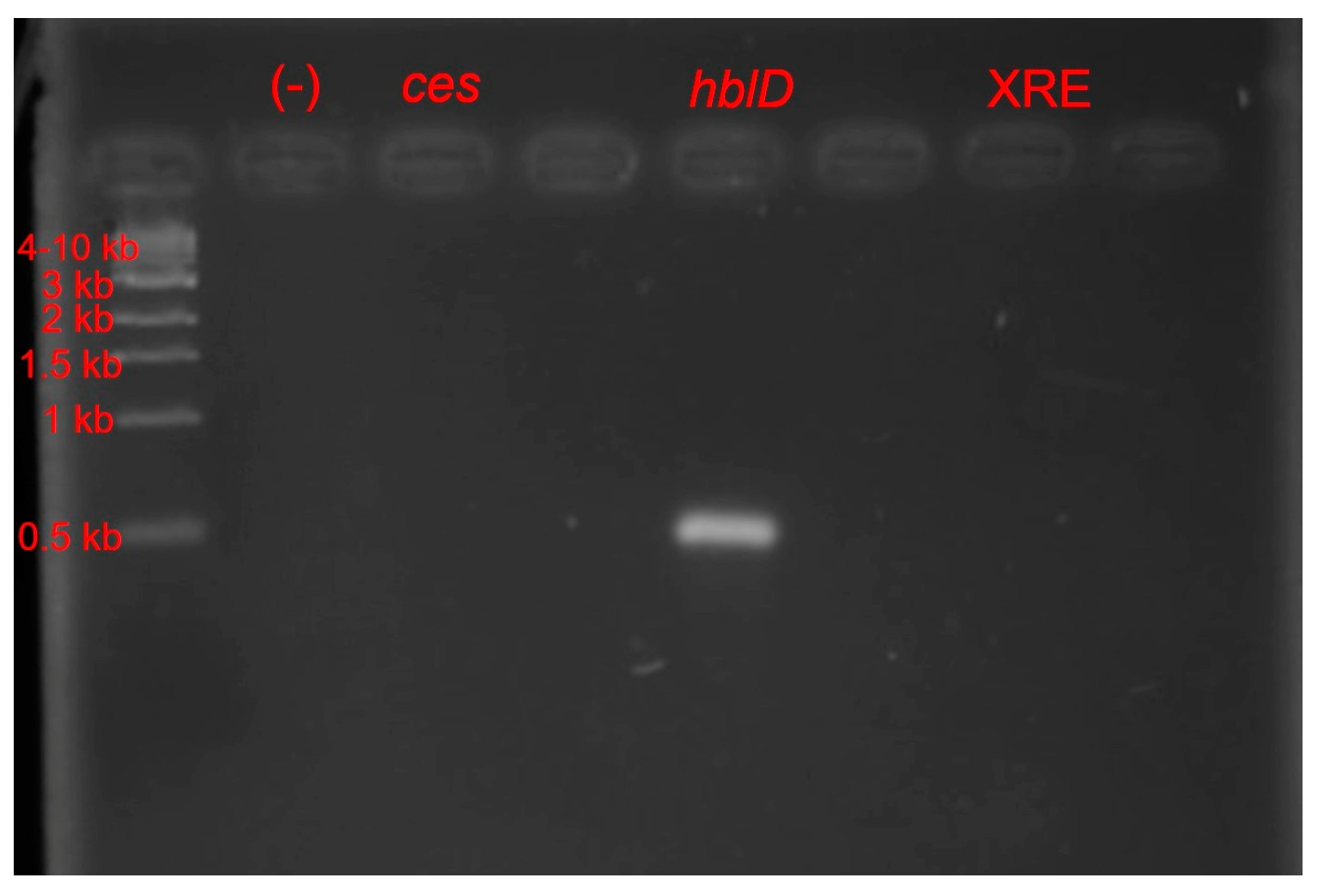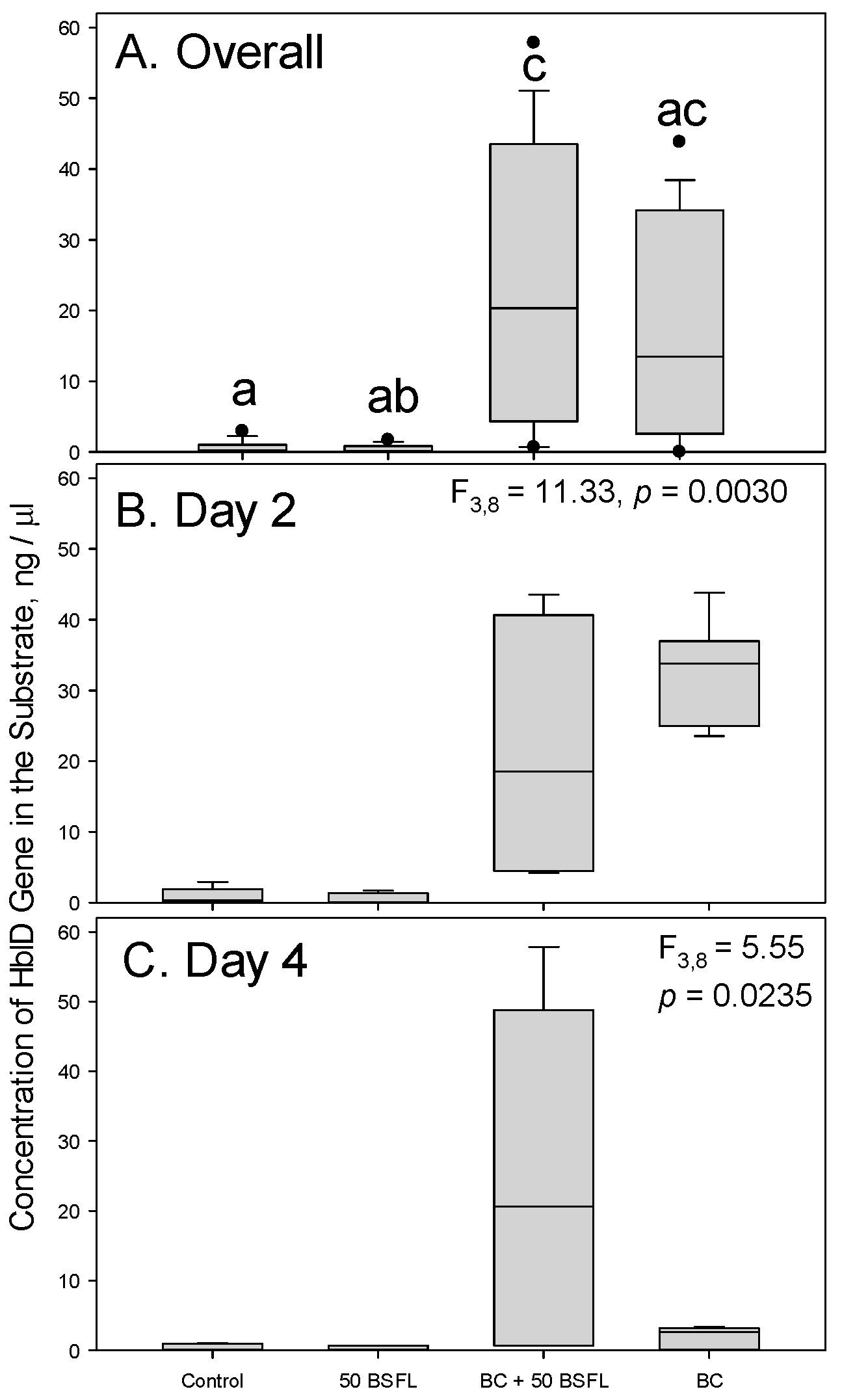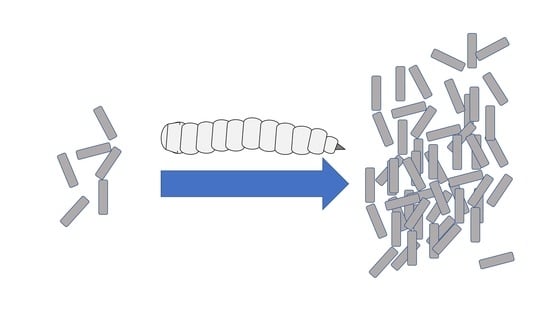Early Growth Patterns of Bacillus cereus on Potato Substrate in the Presence of Low Densities of Black Soldier Fly Larvae
Abstract
:1. Introduction
2. Materials and Methods
2.1. Insect Origins
2.2. Bacillus cereus Strain
2.3. Sterilization and Preparation of Materials
2.4. Experimental Setup
2.5. Sampling and Plating of Substrate
2.6. Extraction and Preparation of Genomic Material
2.7. Diagnostic PCR Setup
2.8. Quantitative (qPCR) Setup
2.9. Statistical Analysis
3. Results
3.1. Colony Count Results Using Selective and Non-Selective Media
3.2. Detection and Quantification of B. cereus DNA within Substrate
4. Discussion
Author Contributions
Funding
Institutional Review Board Statement
Informed Consent Statement
Data Availability Statement
Acknowledgments
Conflicts of Interest
References
- Purschke, B.; Scheibelberger, R.; Axmann, S.; Adler, A.; Jäger, H. Impact of Substrate Contamination with Mycotoxins, Heavy Metals and Pesticides on the Growth Performance and Composition of Black Soldier Fly Larvae (Hermetia illucens) for Use in the Feed and Food Value Chain. Food Addit. Contam. Part A 2017, 34, 1410–1420. [Google Scholar] [CrossRef]
- Vandeweyer, D.; De Smet, J.; Van Looveren, N.; Van Campenhout, L. Biological Contaminants in Insects as Food and Feed. J. Insects Food Feed 2021, 7, 807–822. [Google Scholar] [CrossRef]
- Bonelli, M.; Bruno, D.; Brilli, M.; Gianfranceschi, N.; Tian, L.; Tettamanti, G.; Caccia, S.; Casartelli, M. Black Soldier Fly Larvae Adapt to Different Food Substrates through Morphological and Functional Responses of the Midgut. Int. J. Mol. Sci. 2020, 21, 4955. [Google Scholar] [CrossRef] [PubMed]
- Bruno, D.; Montali, A.; Mastore, M.; Brivio, M.F.; Mohamed, A.; Tian, L.; Grimaldi, A.; Casartelli, M.; Tettamanti, G. Insights Into the Immune Response of the Black Soldier Fly Larvae to Bacteria. Front. Immunol. 2021, 12, 745160. [Google Scholar] [CrossRef] [PubMed]
- Liu, Q.; Tomberlin, J.K.; Brady, J.A.; Sanford, M.R.; Yu, Z. Black Soldier Fly (Diptera: Stratiomyidae) Larvae Reduce Escherichia coli in Dairy Manure. Environ. Entomol. 2008, 37, 1525–1530. [Google Scholar] [CrossRef]
- Bessa, L.W.; Pieterse, E.; Marais, J.; Dhanani, K.; Hoffman, L.C. Food Safety of Consuming Black Soldier Fly (Hermetia illucens) Larvae: Microbial, Heavy Metal and Cross-Reactive Allergen Risks. Foods 2021, 10, 1934. [Google Scholar] [CrossRef] [PubMed]
- Choi, W.-H.; Yun, J.-H.; Chu, J.-P.; Chu, K.-B. Antibacterial Effect of Extracts of Hermetia illucens (Diptera: Stratiomyidae) Larvae against Gram-Negative Bacteria: Hermetia illucens Antibacterial Activity. Entomol. Res. 2012, 42, 219–226. [Google Scholar] [CrossRef]
- Park, S.-I.; Yoe, S.M. Defensin-like Peptide3 from Black Solder Fly: Identification, Characterization, and Key Amino Acids for Anti-Gram-Negative Bacteria: Defensin-like Peptide3 from H. illucens. Entomol. Res. 2017, 47, 41–47. [Google Scholar] [CrossRef]
- Kinney, M.; Moyet, M.; Bernard, E.; Alyokhin, A. Suppression of Methicillin-Resistant Staphylococcus Aureus and Reduction of Other Bacteria by Black Soldier Fly Larvae Reared on Potato Substrate. Microbiol. Spectr. 2022, 10, e02321-22. [Google Scholar] [CrossRef]
- Kim, M.-J.; Han, J.; Park, J.-S.; Lee, J.-S.; Lee, S.-H.; Cho, J.-I.; Kim, K.-S. Various Enterotoxin and Other Virulence Factor Genes Widespread among Bacillus cereus and Bacillus thuringiensis Strains. J. Microbiol. Biotechnol. 2015, 25, 872–879. [Google Scholar] [CrossRef]
- Oh, M.-H.; Ham, J.-S.; Seol, K.-H.; Jang, A.-R.; Lee, S.-G.; Lee, J.-M.; Park, B.-Y.; Kang, E.-S.; Kwon, K.-S.; Hwang, I.-G. Growth Profile and Toxigenicity of Bacillus cereus in Ready-to-Eat Food Products of Animal Origin. Korean J. Food Sci. Anim. Resour. 2011, 31, 40–46. [Google Scholar] [CrossRef]
- Huang, Y.; Flint, S.H.; Yu, S.; Ding, Y.; Palmer, J.S. Phenotypic Properties and Genotyping Analysis of Bacillus cereus Group Isolates from Dairy and Potato Products. LWT 2021, 140, 110853. [Google Scholar] [CrossRef]
- Heini, N.; Stephan, R.; Ehling-Schulz, M.; Johler, S. Characterization of Bacillus cereus Group Isolates from Powdered Food Products. Int. J. Food Microbiol. 2018, 283, 59–64. [Google Scholar] [CrossRef] [PubMed]
- Tallent, S.M.; Hait, J.M.; Ferguson, M. Comparative Study of Tempo BC Automated MPN for the Enumeration of Bacillus cereus Group in Food. J. Food Saf. 2018, 38, e12472. [Google Scholar] [CrossRef]
- Fangio, M.F.; Roura, S.I.; Fritz, R. Isolation and Identification of Bacillus Spp. and Related Genera from Different Starchy Foods. J. Food Sci. 2010, 75, M218–M221. [Google Scholar] [CrossRef] [PubMed]
- Vaikundamoorthy, R.; Rajendran, R.; Selvaraju, A.; Moorthy, K.; Perumal, S. Development of Thermostable Amylase Enzyme from Bacillus cereus for Potential Antibiofilm Activity. Bioorganic Chem. 2018, 77, 494–506. [Google Scholar] [CrossRef] [PubMed]
- Sheppard, D.C.; Tomberlin, J.K.; Joyce, J.A.; Kiser, B.C.; Sumner, S.M. Rearing Methods for the Black Soldier Fly (Diptera: Stratiomyidae). J. Med. Entomol. 2002, 39, 695–698. [Google Scholar] [CrossRef]
- Procop, G.W.; Church, D.L.; Hall, G.S.; Janda, W.M.; Koneman, E.W.; Schreckenberger, P.C.; Woods, G.L. Koneman’s Color Atlas and Textbook of Diagnostic Microbiology, 7th ed.; Jones & Bartlett Learning: Burlington, MA, U.S.A, 2017; p. 844. [Google Scholar]
- Zhang, Z.; Feng, L.; Xu, H.; Liu, C.; Shah, N.P.; Wei, H. Detection of Viable Enterotoxin-Producing Bacillus cereus and Analysis of Toxigenicity from Ready-to-Eat Foods and Infant Formula Milk Powder by Multiplex PCR. J. Dairy Sci. 2016, 99, 1047–1055. [Google Scholar] [CrossRef] [PubMed]
- Fricker, M.; Messelhäußer, U.; Busch, U.; Scherer, S.; Ehling-Schulz, M. Diagnostic Real-Time PCR Assays for the Detection of Emetic Bacillus cereus Strains in Foods and Recent Food-Borne Outbreaks. Appl Environ. Microbiol 2007, 73, 1892–1898. [Google Scholar] [CrossRef]
- Wei, S.; Chelliah, R.; Park, B.-J.; Kim, S.-H.; Forghani, F.; Cho, M.S.; Park, D.-S.; Jin, Y.-G.; Oh, D.-H. Differentiation of Bacillus thuringiensis from Bacillus cereus Group Using a Unique Marker Based on Real-Time PCR. Front. Microbiol. 2019, 10, 883. [Google Scholar] [CrossRef] [PubMed]
- Conover, W.J.; Iman, R.L. Rank Transformations as a Bridge between Parametric and Nonparametric Statistics. Am. Stat. 1981, 35, 124–129. [Google Scholar]
- Wobbrock, J.O.; Findlater, L.; Gergle, D.; Higgins, J.J. The Aligned Rank Transform for Nonparametric Factorial Analyses Using Only ANOVA Procedures. In Proceedings of the SIGCHI Conference on Human Factors in Computing Systems, Vancouver, BC, Canada, 7–12 May 2011; ACM: Vancouver, BC, Canada, 2011; pp. 143–146. [Google Scholar] [CrossRef]
- Bernard, E.; Villazana, J.; Alyokhin, A.; Rose, J. Colonisation of Finfish Substrate Inhabited by Black Soldier Fly Larvae by Blow Flies, Bacteria, and Fungi. J. Insects Food Feed 2020, 6, 291–304. [Google Scholar] [CrossRef]
- Erickson, M.C.; Islam, M.; Sheppard, C.; Liao, J.; Doyle, M.P. Reduction of Escherichia coli O157:H7 and Salmonella enterica Serovar Enteritidis in Chicken Manure by Larvae of the Black Soldier Fly. J. Food Prot. 2004, 67, 685–690. [Google Scholar] [CrossRef] [PubMed]
- Callegari, M.; Jucker, C.; Fusi, M.; Leonardi, M.G.; Daffonchio, D.; Borin, S.; Savoldelli, S.; Crotti, E. Hydrolytic Profile of the Culturable Gut Bacterial Community Associated with Hermetia illucens. Front. Microbiol. 2020, 11, 1965. [Google Scholar] [CrossRef]
- Diener, S.; Zurbrügg, C.; Tockner, K. Conversion of Organic Material by Black Soldier Fly Larvae: Establishing Optimal Feeding Rates. Waste Manag. Res. 2009, 27, 603–610. [Google Scholar] [CrossRef]
- Parra Paz, A.S.; Carrejo, N.S.; Gómez Rodríguez, C.H. Effects of Larval Density and Feeding Rates on the Bioconversion of Vegetable Waste Using Black Soldier Fly Larvae Hermetia illucens (L.), (Diptera: Stratiomyidae). Waste Biomass Valoriz. 2015, 6, 1059–1065. [Google Scholar] [CrossRef]
- Broeckx, L.; Frooninckx, L.; Slegers, L.; Berrens, S.; Noyens, I.; Goossens, S.; Verheyen, G.; Wuyts, A.; Van Miert, S. Growth of Black Soldier Fly Larvae Reared on Organic Side-Streams. Sustainability 2021, 13, 12953. [Google Scholar] [CrossRef]
- Rabani, V.; Cheatsazan, H.; Davani, S. Proteomics and Lipidomics of Black Soldier Fly (Diptera: Stratiomyidae) and Blow Fly (Diptera: Calliphoridae) Larvae. J. Insect Sci. 2019, 19, 29. [Google Scholar] [CrossRef]
- Goodbrod, J.R.; Goff, M.L. Effects of Larval Population Density on Rates of Development and Interactions between Two Species of Chrysomya (Diptera: Calliphoridae) in Laboratory Culture. J. Med. Entomol. 1990, 27, 338–343. [Google Scholar] [CrossRef]
- Green, P.W.C.; Simmonds, M.S.J.; Blaney, W.M. Diet Nutriment and Rearing Density Affect the Growth of Black Blowfly Larvae, Phormia regina (Diptera: Calliphoridae). Eur. J. Entomol. 2003, 100, 39–42. [Google Scholar] [CrossRef]
- Tegtmeier, D.; Hurka, S.; Mihajlovic, S.; Bodenschatz, M.; Schlimbach, S.; Vilcinskas, A. Culture-Independent and Culture-Dependent Characterization of the Black Soldier Fly Gut Microbiome Reveals a Large Proportion of Culturable Bacteria with Potential for Industrial Applications. Microorganisms 2021, 9, 1642. [Google Scholar] [CrossRef]
- Wu, N.; Liang, J.; Wang, X.; Xie, S.; Xu, X. Copper Stimulates the Incidence of Antibiotic Resistance, Metal Resistance and Potential Pathogens in the Gut of Black Soldier Fly Larvae. J. Environ. Sci. 2021, 107, 150–159. [Google Scholar] [CrossRef]
- Candian, V.; Meneguz, M.; Tedeschi, R. Immune Responses of the Black Soldier Fly Hermetia illucens (L.) (Diptera: Stratiomyidae) Reared on Catering Waste. Life 2023, 13, 213. [Google Scholar] [CrossRef] [PubMed]
- Wynants, E.; Frooninckx, L.; Crauwels, S.; Verreth, C.; De Smet, J.; Sandrock, C.; Wohlfahrt, J.; Van Schelt, J.; Depraetere, S.; Lievens, B.; et al. Assessing the Microbiota of Black Soldier Fly Larvae (Hermetia illucens) Reared on Organic Waste Streams on Four Different Locations at Laboratory and Large Scale. Microb. Ecol. 2019, 77, 913–930. [Google Scholar] [CrossRef] [PubMed]
- Schreven, S.J.J.; de Vries, H.; Hermes, G.D.A.; Zeni, G.; Smidt, H.; Dicke, M.; van Loon, J.J.A. Black Soldier Fly Larvae Influence Internal and Substrate Bacterial Community Composition Depending on Substrate Type and Larval Density. Appl. Environ. Microbiol. 2022, 88, e00084-22. [Google Scholar] [CrossRef] [PubMed]
- de Vries, Y.P.; Hornstra, L.M.; de Vos, W.M.; Abee, T. Growth and Sporulation of Bacillus cereus ATCC 14579 under Defined Conditions: Temporal Expression of Genes for Key Sigma Factors. Appl. Environ. Microbiol. 2004, 70, 2514–2519. [Google Scholar] [CrossRef]
- Bressuire-Isoard, C.; Broussolle, V.; Carlin, F. Sporulation Environment Influences Spore Properties in Bacillus: Evidence and Insights on Underlying Molecular and Physiological Mechanisms. FEMS Microbiol. Rev. 2018, 42, 614–626. [Google Scholar] [CrossRef]
- Knüpfer, M.; Braun, P.; Baumann, K.; Rehn, A.; Antwerpen, M.; Grass, G.; Wölfel, R. Evaluation of a Highly Efficient DNA Extraction Method for Bacillus Anthracis Endospores. Microorganisms 2020, 8, 763. [Google Scholar] [CrossRef]
- Roopnarain, A.; Mukhuba, M.; Adeleke, R.; Moeletsi, M. Biases during DNA Extraction Affect Bacterial and Archaeal Community Profile of Anaerobic Digestion Samples. 3 Biotech 2017, 7, 375. [Google Scholar] [CrossRef]
- Awasthi, M.K.; Liu, T.; Awasthi, S.K.; Duan, Y.; Pandey, A.; Zhang, Z. Manure Pretreatments with Black Soldier Fly Hermetia illucens L. (Diptera: Stratiomyidae): A Study to Reduce Pathogen Content. Sci. Total Environ. 2020, 737, 139842. [Google Scholar] [CrossRef]
- Liu, T.; Klammsteiner, T.; Dregulo, A.M.; Kumar, V.; Zhou, Y.; Zhang, Z.; Awasthi, M.K. Black Soldier Fly Larvae for Organic Manure Recycling and Its Potential for a Circular Bioeconomy: A Review. Sci. Total Environ. 2022, 833, 155122. [Google Scholar] [CrossRef] [PubMed]




| Target | Primer Sequence (5′-3′) | Function | Amplicon Length | Reference |
|---|---|---|---|---|
| hblD | GTTAGATACAGCGAAGCCAC | Forward Primer | 465 bp | [19] |
| CCGCCAGTTACAACAATA | Reverse Primer | |||
| ces | CGCCGAAAGTGATTATACCAA | Forward Primer | 103 bp | [20] |
| TATGCCCCGTTCTCAAACTG | Reverse Primer | |||
| XRE | AAGATATTGCAAGCGGTAAGAT | Forward Primer | 270 bp | [21] |
| GTTTTGTTTCAGCATTCCAGTAA | Reverse Primer |
| Primer Set | Melting Temp | Annealing Temp | Elongation Temp | Primer Concentration | Amplicon Length | Cycle Number |
|---|---|---|---|---|---|---|
| hblD | 95 °C Initial = 10 min Cycle = 30 s | 52.2 °C Cycle = 30 s | 72 °C Cycle = 30 s Final = 10 min | 0.2 µM | 465 bp | 35 |
| Ces | 95 °C Initial = 2 min Cycle = 30 s | 60 °C Cycle = 60 s | 72 °C Cycle = 30 s Final = 5 min | 0.3 µM | 103 bp | 35 |
| XRE | 95 °C Initial = 5 min Cycle = 30 s | 49 °C Cycle = 30s | 72 °C Cycle = 30 s Final = 5min | 0.3 µM | 246 bp | 35 |
| Treatment | Replicate | Day 2 | Day 4 |
|---|---|---|---|
| Substrate | A | − | − |
| B | − | − | |
| C | − | − | |
| Larvae | A | − | − |
| B | − | − | |
| C | − | − | |
| Larvae and Pathogen | A | + | + |
| B | + | + | |
| C | + | + | |
| Pathogen | A | + | + |
| B | − | − | |
| C | − | − |
Disclaimer/Publisher’s Note: The statements, opinions and data contained in all publications are solely those of the individual author(s) and contributor(s) and not of MDPI and/or the editor(s). MDPI and/or the editor(s) disclaim responsibility for any injury to people or property resulting from any ideas, methods, instructions or products referred to in the content. |
© 2023 by the authors. Licensee MDPI, Basel, Switzerland. This article is an open access article distributed under the terms and conditions of the Creative Commons Attribution (CC BY) license (https://creativecommons.org/licenses/by/4.0/).
Share and Cite
Moyet, M.; Morrill, H.; Espinal, D.L.; Bernard, E.; Alyokhin, A. Early Growth Patterns of Bacillus cereus on Potato Substrate in the Presence of Low Densities of Black Soldier Fly Larvae. Microorganisms 2023, 11, 1284. https://doi.org/10.3390/microorganisms11051284
Moyet M, Morrill H, Espinal DL, Bernard E, Alyokhin A. Early Growth Patterns of Bacillus cereus on Potato Substrate in the Presence of Low Densities of Black Soldier Fly Larvae. Microorganisms. 2023; 11(5):1284. https://doi.org/10.3390/microorganisms11051284
Chicago/Turabian StyleMoyet, Matthew, Hailey Morrill, Daniella Leal Espinal, Edward Bernard, and Andrei Alyokhin. 2023. "Early Growth Patterns of Bacillus cereus on Potato Substrate in the Presence of Low Densities of Black Soldier Fly Larvae" Microorganisms 11, no. 5: 1284. https://doi.org/10.3390/microorganisms11051284
APA StyleMoyet, M., Morrill, H., Espinal, D. L., Bernard, E., & Alyokhin, A. (2023). Early Growth Patterns of Bacillus cereus on Potato Substrate in the Presence of Low Densities of Black Soldier Fly Larvae. Microorganisms, 11(5), 1284. https://doi.org/10.3390/microorganisms11051284









